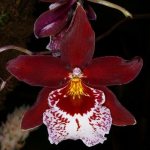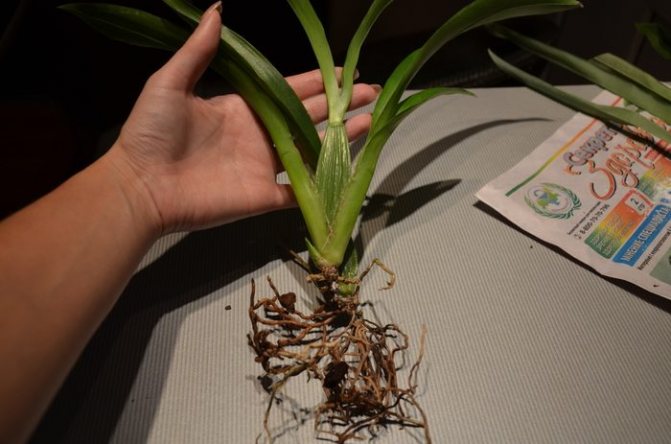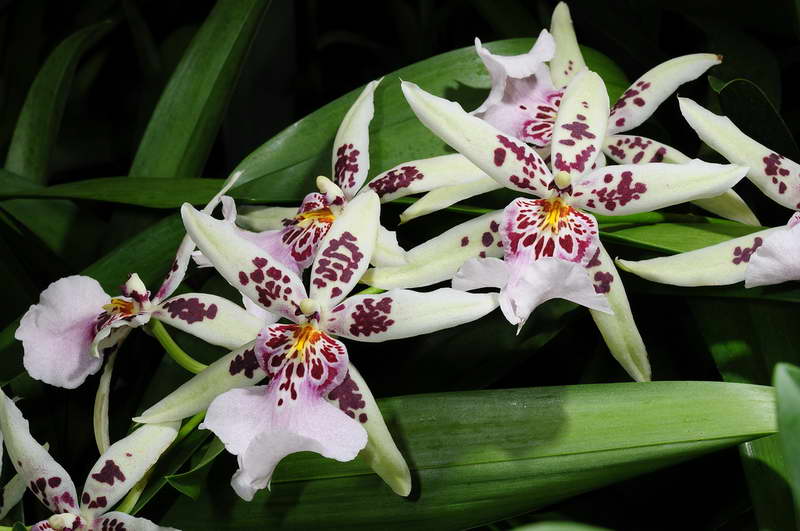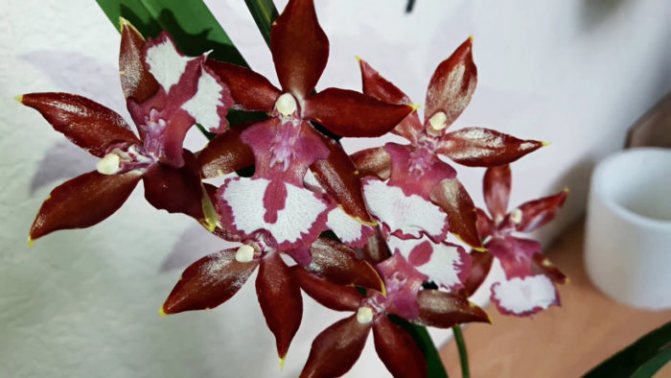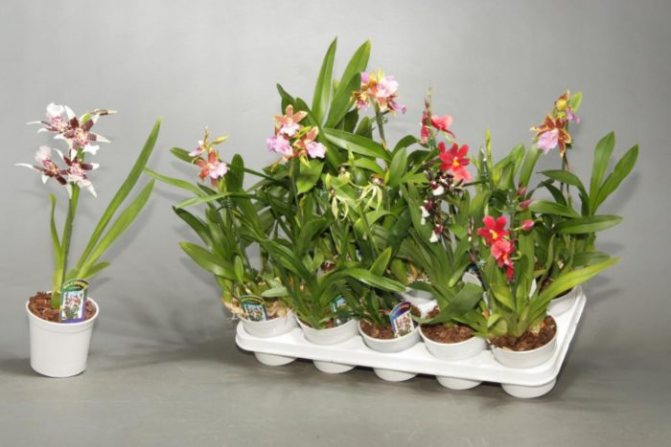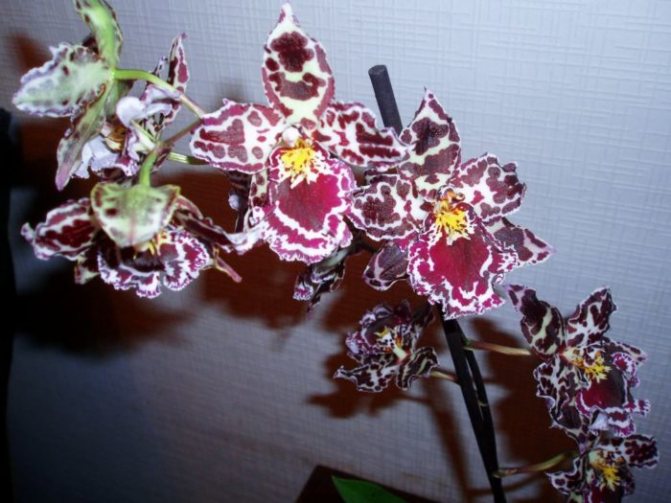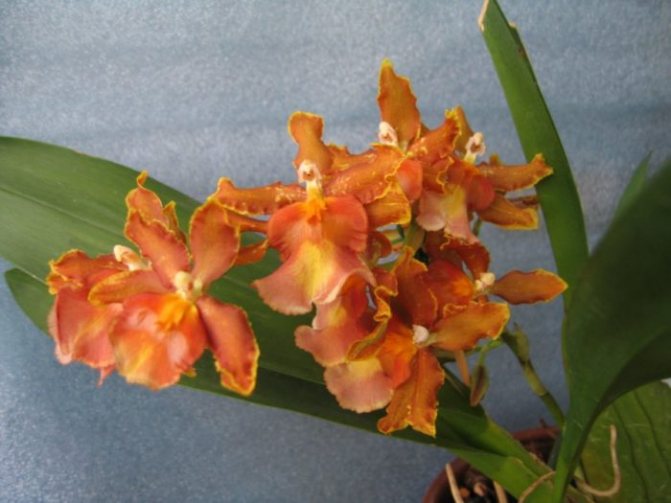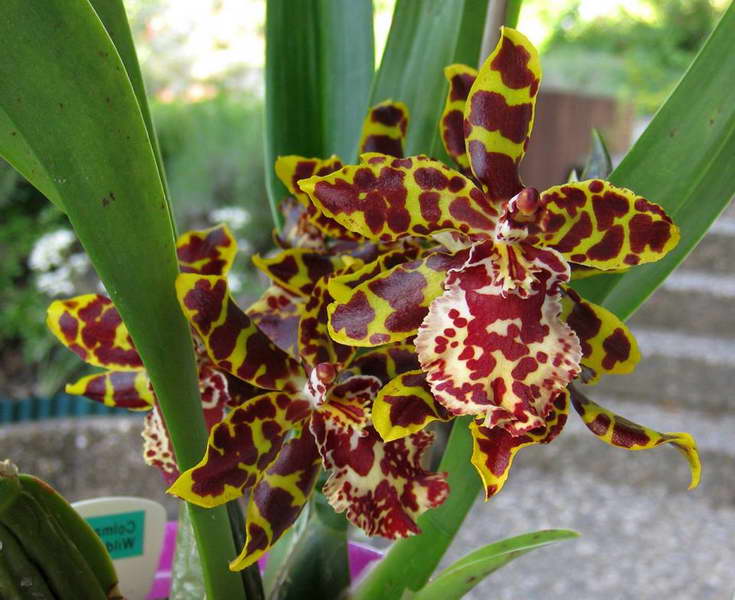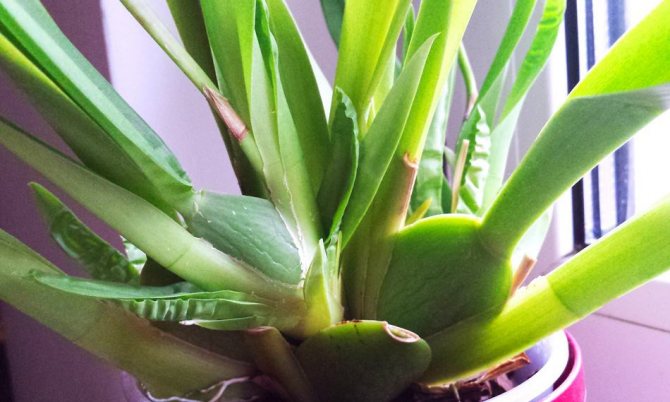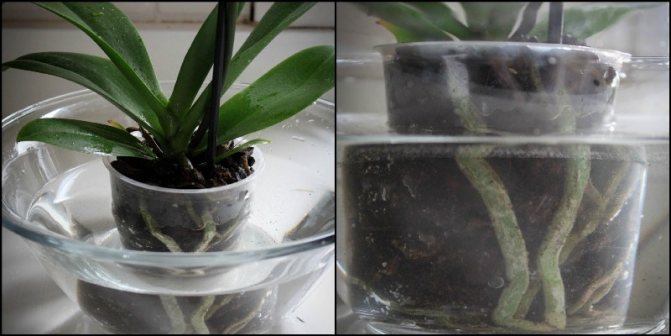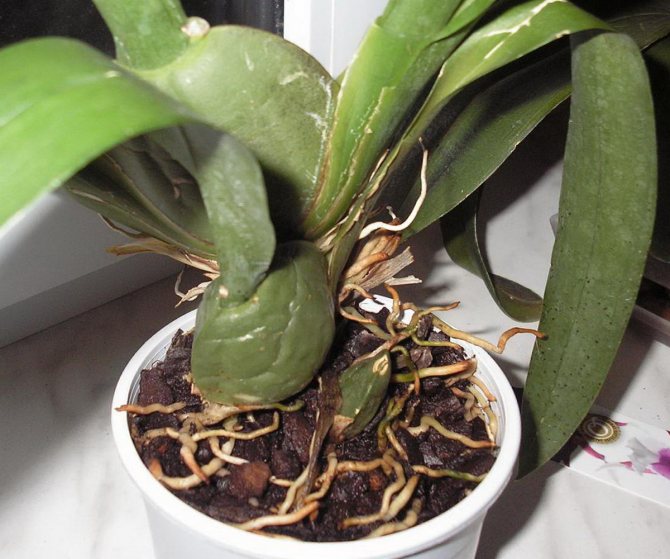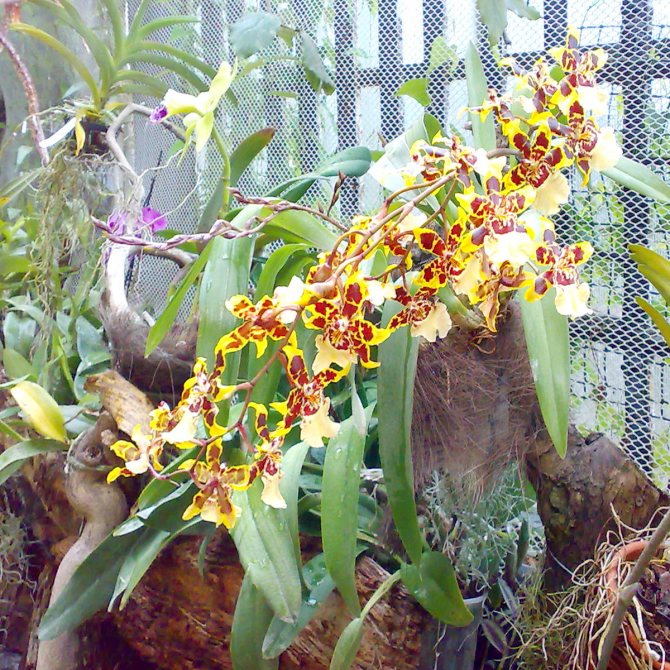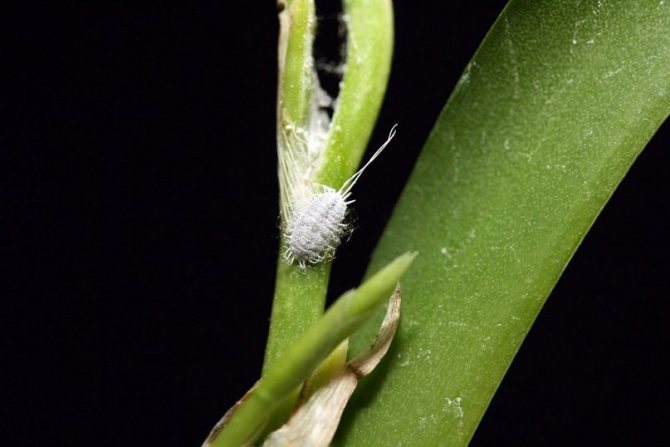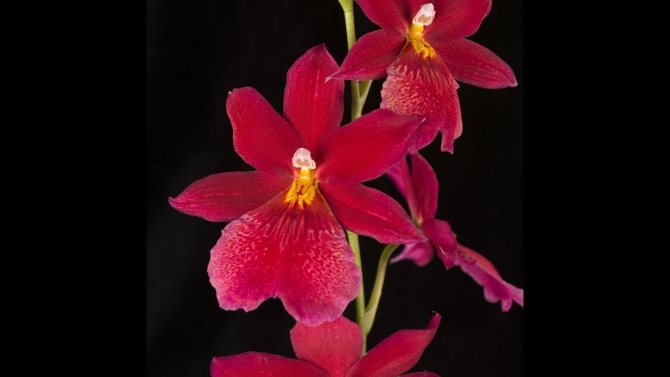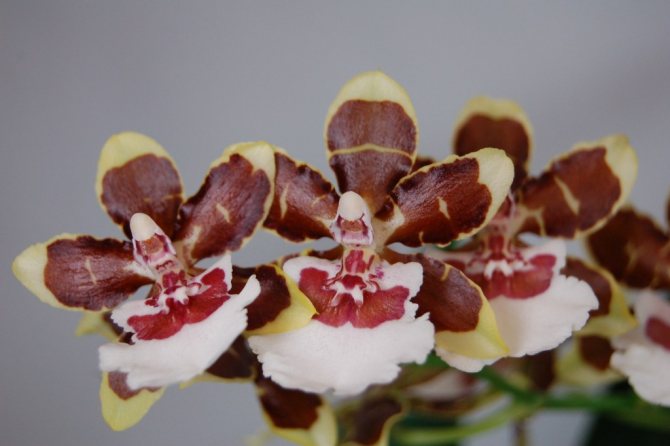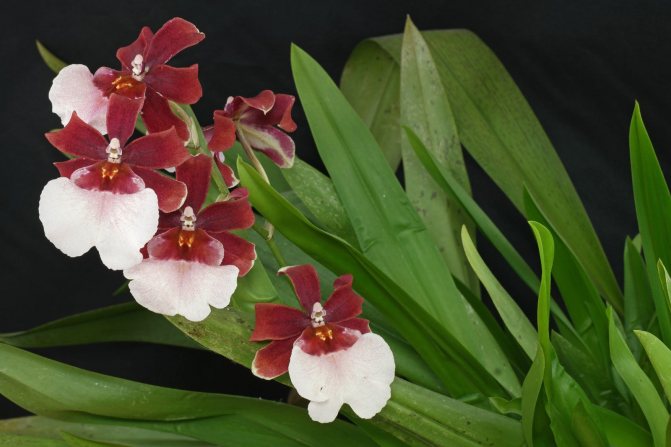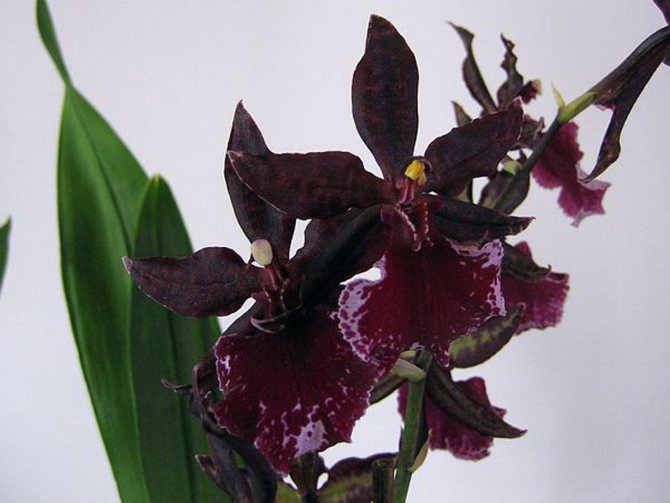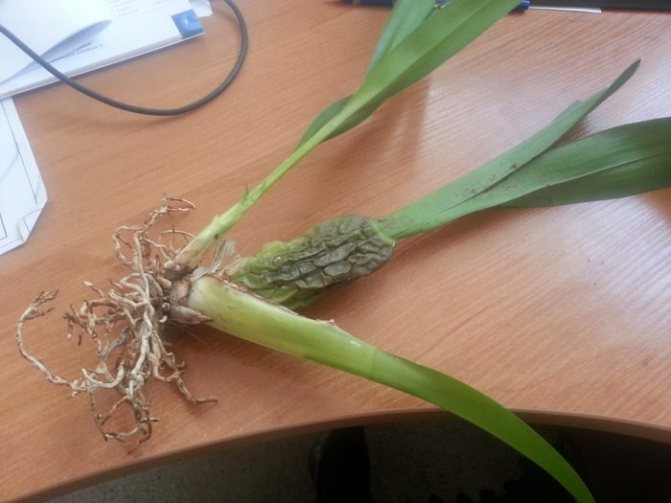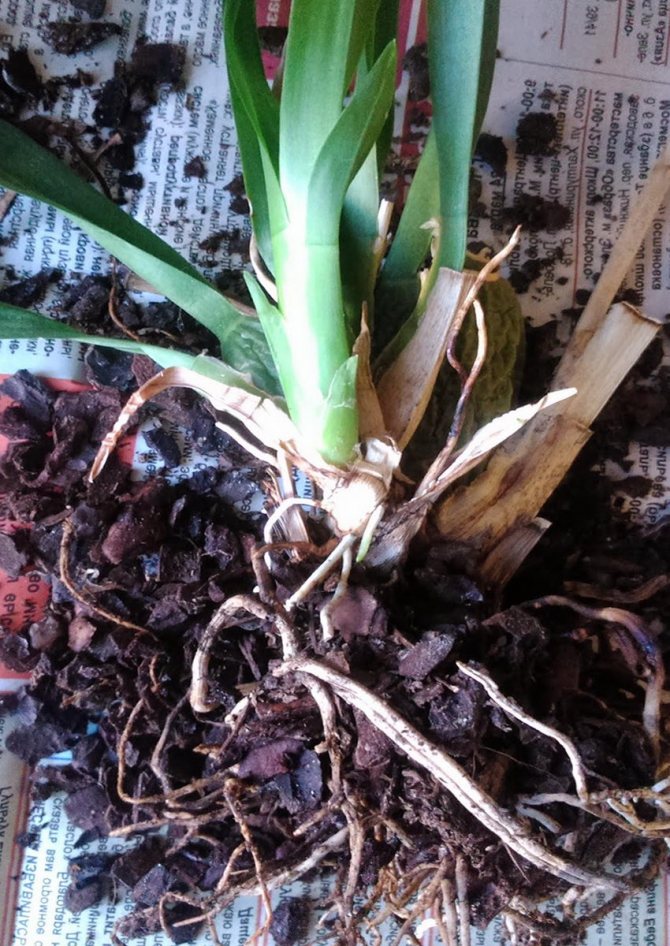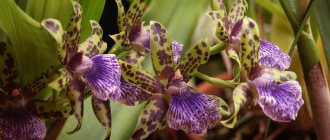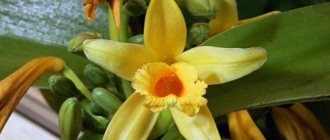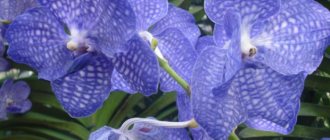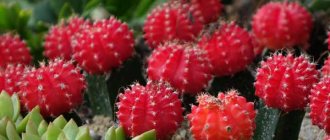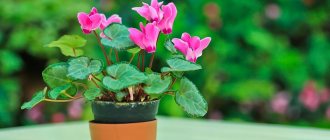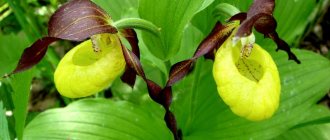The Cambria Orchid is a complex hybrid bred with great diligence by experienced breeders. It combines the best qualities of its parents, inheriting the unearthly beauty of bright flowers, an unusual shape, a rich aroma and an abundance of intricate patterns on the petals. The shape of the pseudobulb is oblong or oval, with a diameter of no more than seven centimeters. There are leaves on them, with a palette of colors ranging from dark green to bright red and yellow-orange. The root system is well developed, the support function is in the substrate.
Cumbria orchid: variety description and home care
The history of Cumbria began in 1900.when Charles Vuilsteke, of Belgian descent, got the first hybrid and named it Vuylstekeara Cambria ‘Plush’. Since that time, almost all varieties have been named by orchid breeders.
It is a complex hybrid of the sympodial orchid family. - growing horizontally, having several points of growth, more resembling a vine in shape.
The resulting lateral shoots give out pseudobulbs that are used for propagation. Bulbs are oval - flattened or elongated - fusiform, blooming only once, form 1-2 peduncles.
Each pseudobulb is crowned with long, narrow broad-lanceolate leaves, closely pressed against each other, reaching up to half a meter in some species. The leaf is dark green with a prominent central vein.
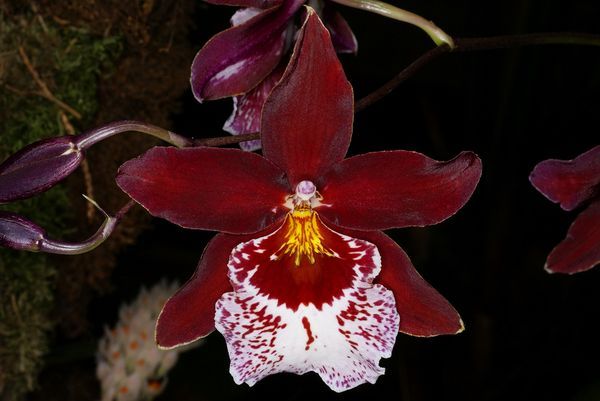
Vuylstekeara Cambria 'Plush'.
Flowers of various shapes and colors with a diameter of up to 10 cm... The lush blooming Cambria is, as it were, covered with precious stones.
The roots are thin, filamentous, mainly for the stability of the plant in the substrate. After the pseudobulb has bloomed, the roots die off. But young bulbs quickly take root, some of which remain airy and serve to obtain food and moisture from the air.


Cumbria Orchid.
Important! Unlike other orchid species, Cambria's root system does not participate in photosynthesis.
Distinctive features
Of the distinctive features is the shoot type of growth. It is this feature that distinguishes it from other orchids. Another pronounced difference between some species is flower shape - asterisk, therefore, it is often Cumbria that is called an asterisk orchid.
What are Bulbs and Pseudobulbs?
Sympodial orchids bulb (pseudobulb, tuberedia, false bulb, pseudo bulb, aerial tuber) - near-earth, thickened part of the stem located near the substrate... The main purpose is to accumulate moisture and nutrients, which is typical for epiphytes growing in tropical latitudes. In Cumbria, pseudobulbs reach 8 cm in length.
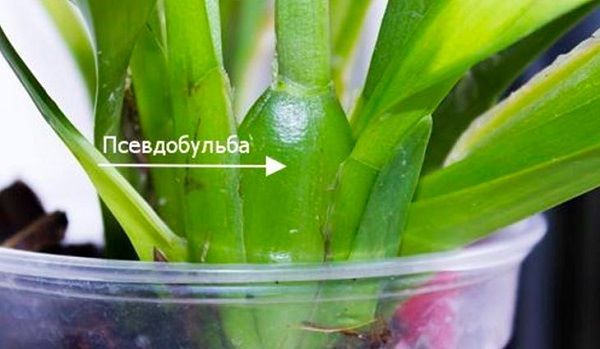

Bulba (pseudobulba) orchids.
Most common colors
The colors can be very diverse, depending on which type of orchid the hybrid is obtained. Among the most common and popular for home growing:
- yellow;
- red;
- pink;
- white-pink-purple;
- cream.
Each of these colors can have different shades, with or without splashes, patterns, spots, stains.
Variety of varieties
More than five different varieties are hidden behind the common name "cambria".An orchid with fragrant large flowers was obtained through the selection of wild-growing brassia. The petals of these flowers taper towards the edges, so they can be easily distinguished by their appearance. Varietal hybrids of miltonia look very presentable. Outwardly, their flowers are a bit like domestic pansies. Less common varieties are Colmanars, Wilsonars and Beallars. They have flowers of the most outlandish colors and shapes. However, they do not emit a pleasant smell. Another type of cambria is a hybrid with the complex name of wilstekeara. Large flowers can be red, pink or burgundy. Each cambrian orchid is beautiful in its own way.
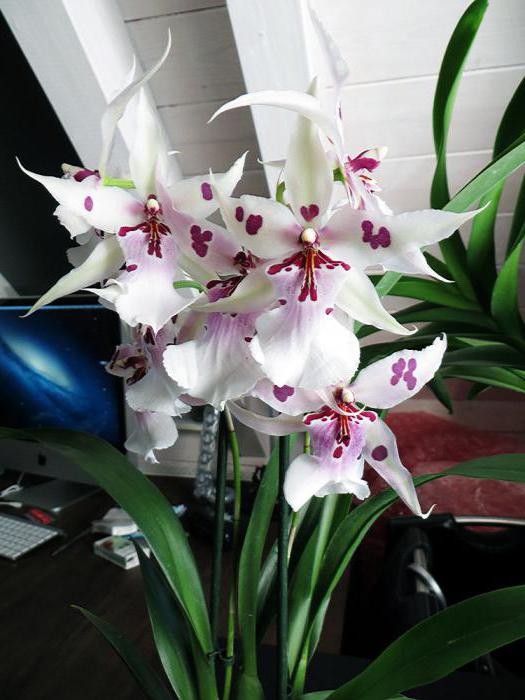

Varieties of Cumbria orchids
Mix
The prefix "mix" only means that the flower is of unnatural origin.
And since Cambria is not a natural phenomenon anyway, the mix is used for commercial purposes.
This means that Cumbria without the prefix mix and Cambria mix are one and the same complex hybrid of orchids, with a large number of varieties.
Beallara Margarita Hill
A complex hybrid with fairly high peduncles and numerous flowers, with unusual coloration of dark red with white lines, strokes and spots.
Blooms almost all year round, each year increasing the number of flowering arrows. The flowers have a light aroma.


Beallara margarita hill.
Catatante Pacific Sun Sports
Typical for this type of orchid is the crossing of several species. It is characterized by shoot growth, oval pseudobulbs and narrow long leaves with pointed ends.
It stands out for its unusually beautiful color of flowers... Dark red, purple, orange flowers with lines and spots of white color are quite large in size.


Catatante Pacific Sun Sports.
Colmanara Tropic Jungle
Selection of several species, with high peduncles, oval pseudo-bulbs and narrow, pointed, rather long leaves with parallel venation.
Blooms usually twice a year. with a dozen flowers on each peduncle. The color scheme combines red, white, yellow and brown. The fleshy outgrowth of the white-red lip stands out. It emits a light aroma at certain times.


Colmanara Tropic Jungle.
Odontoglossum Stirbik
Although Odontoglossum prefers a cool content, it develops successfully in an apartment environment. Regular growth of bulbs contributes to the appearance of new peduncles, which become more and more with age. The leaves are narrow and long, lanceolate, light green in color.
On tall peduncles, usually from 2 to 7 star-like flowers, with bright stripes, spots of red, white, yellow and burgundy. It emits a light aroma that intensifies at certain times.


Odontoglossum Stirbik.
Description and distinctive features of the plant
An orchid of the cambria species is an artificially bred hybrid; it does not exist in the natural environment. External characteristics of the flower:
- the formation of convex pseudobulbs;
- elongated narrow leaves of deep green color;
- flowers have a varied shape, most often round or star-shaped;
- flower diameter - up to 10 cm;
- any color, including variegated, but more often red, yellow, brown, purple.
The main feature that distinguishes the Cambrian species from other orchids is the development of shoots. Another notable feature is the star-shaped shape of the petals, for which the plant is called an asterisk.
Testimonials
Oleg. “I have been keeping orchids for more than one year and I like Cambria much more than Phalaenopsis. If the second needs to be stimulated somehow for flowering, then Cambria successfully blooms with each new bulb. And she creates fewer problems in leaving. "
Marina. “Let's see what happens with my Cambria, which I recently bought at a sale in a flower center. It is a pity that I bought it already faded. But so far, even without flowers, it looks much better due to more greenery than other types of orchid. "
Elena. “I have been growing orchids for many years, since I have a place in my house. There are Wolstekeara, Burrageara, Colmonara, Brassia, Miltassia, Dendrobium Nobile and a few faliks. Bastard from them. I'm ready to spend hours doing such beauty. In addition, Cumbria also emit aroma. What is also important is that it is easy to care for and home conditions are great. For more than 10 years, they have not had any illnesses. "
What is the right temperature for growth?
Cambria grows at home at temperatures from +15 to +22 degrees Celsius. Higher temperatures in summer will cause all flowers and buds to crumble. Small fluctuations in temperature at night are allowed, but not more than three degrees. It is this regime that contributes to the good development of the root system and the formation of new inflorescences. If in winter the air temperature drops to + 14 ... + 16 degrees Celsius, the plant can go into a dormant state. However, it is impossible to take out non-blooming cambria onto the balcony. Temperatures below +14 degrees will be detrimental to the plant.
External characteristics
Adult plant height: maximum peduncle length
Peduncles emerge from the axils of the lower leaves. The height of which in adult orchids can reach 60 cm and carry a large number of inflorescences. There are varieties in which they can reach one and a half meter in length - Kolmanar.
Number of leaves
Each pseudobulb bears up to three long, narrow leaves. And on one plant, pseudobulbs can be up to 12 pieces. So that there can be a large number of leaves.
Diameter, flower shape
Most species the flower resembles an asterisk, with a wide, large lower petal and almost twice as narrow as the upper petals. The middle, resembling a tongue and a forked lip, is clearly manifested.
The diameter of the flowers is varied... There are species with small flowers, and there are also 10 cm in diameter. According to flower growers, some flowers reached 15 cm.
The main flower shape consists of 5 sepals and one wide petal called a lip.
Characteristics and varieties
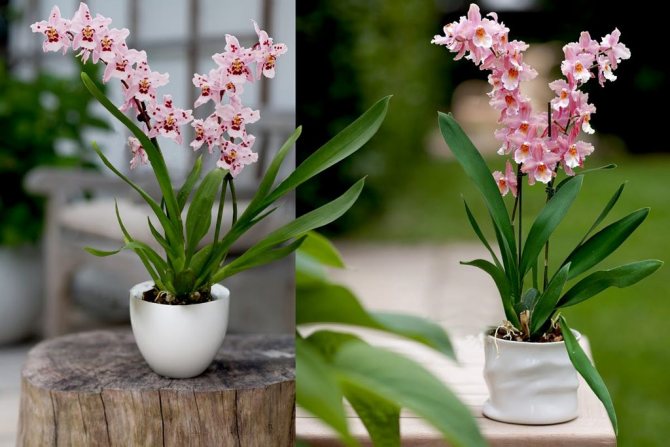

The orchid has a sympodial growth (horizontal). After flowering, the roots die off, and further development begins from a new thickening of the stem - the bulb (during the dormant period). One or two peduncles with a cluster of large flowers emerge from the base of the bulb, there can be up to 20. Their shape resembles a star. The color is predominantly yellow, cream, pink, red and their various shades.
The most extravagant species, all of them are represented by complex hybrids from three or more species:
- Beallara - color of petals from cream to white-pink interspersed with purple dots closer to class = "aligncenter" width = "800" height = "600" [/ img] Beallara
Flowering from mid to late summer season. Derived by combining the species of Brassia, Odontoglossum, Miltonia, as well as Kohlioda. - Burrageara is more refined because of the collected inflorescences.
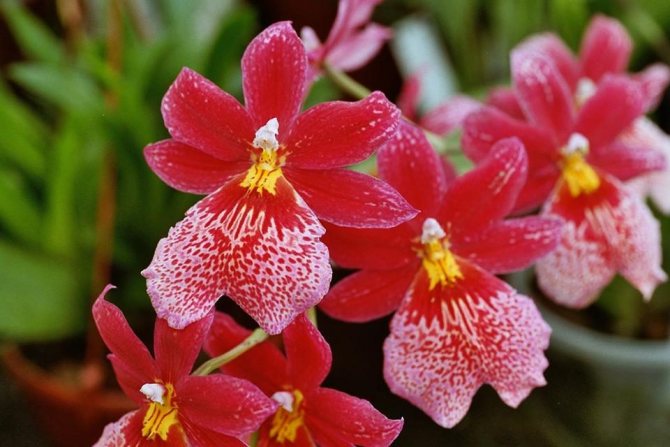

Burrageara
Blooms in winter, dominated by yellow and red colors. There is a scent reminiscent of a rose. The hybrid was obtained by crossing species such as Kohlioda, Oncidium, Miltonia and Odontoglossum. - Vuilstekeara - color in pink, yellow and red with a bizarre pattern.


Wuilstekeara
The flowering period is from late winter to early summer, up to two months. A complex hybrid, obtained by crossing the species Kohlioda, Miltonia and Odontoglossum. - Kolmanara - the colors of the flowers are yellow and red, the pattern is spotted.
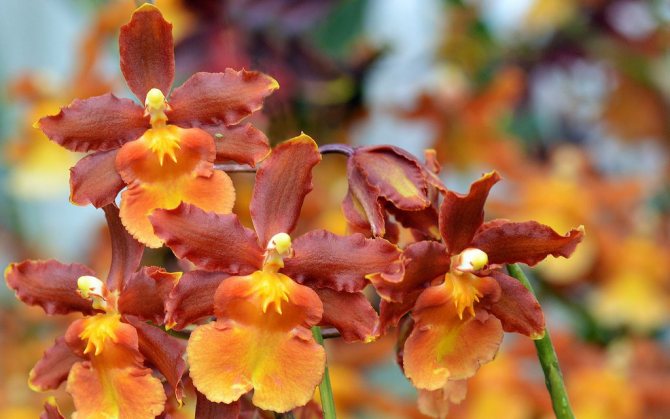

Colmanara
Flowering lasts up to three months. Created by combining three types of Oncidium, Odontoglossum and Miltonia. - Degarmoara is a year-round bloom. Pleasant aroma.
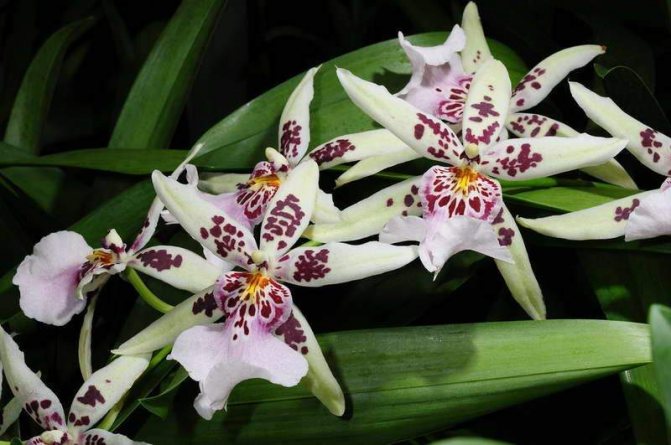

Degarmoara
The colors are varied, the diameter of the flowers is about 10 cm. Received by crossing these species of Odontoglossum, Brassia and Miltonia.
The main features of flowering
Period
Flowering occurs all year round, regardless of the season. If normal temperature conditions are created and the amount of lighting is sufficient. The usual flowering time is in the autumn-winter period.
Duration
Each peduncle, depending on the species, blooms 1-2 months... And since there are several peduncles, a feeling of year-round flowering is created.
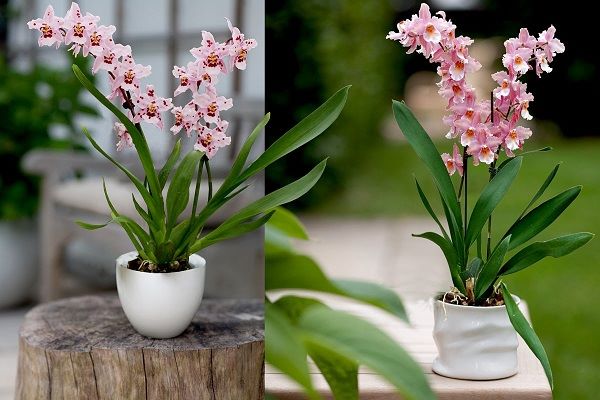

The peduncle can bloom up to 2 months.
Is re-flowering possible?
Pseudobulbs in Cumbria provide its life cycle... Basically, in most species, before blooming, the bulb is poured with juice, gets fat and seems to freeze. And very soon peduncles begin to form from the leaf sinuses.
At the end of flowering, the bulb dries up, and a new sprout forms at its base and a new life cycle begins.
Stimulation
Stimulates flowering lowering the night temperature to 13-15 ° С for 10-14 days... It is better not to stimulate young orchids, but to let them gain strength and energy.
Some Ohideists recommend reducing watering during the growing season of pseudobulbs for a while, allowing them to mature. Then watering is resumed and stopped again. This procedure provokes the plant to eject the peduncle.
Where to place the flower?
If you were presented with one of the most beautiful cambrian hybrids, then first of all you need to find the most suitable place in the apartment for growing a flower. Almost all of the listed varieties are suitable for approximately the same lighting conditions. Cumbria is a photophilous orchid, but the lighting should be diffused. Bright rays will burn not only the leaves of the plant, but also instantly dry the delicate buds. It is best to place the pot on an east or southeast window.
In winter, natural light may not be enough for the orchid. At this time, she can plunge into a state of rest. This is normal. She needs to rest after flowering and gain strength. But if this did not happen, and buds continue to appear on the peduncle, artificial lighting will be required. It is necessary to lengthen the daylight hours using a fluorescent lamp up to 15-18 hours.
Maintenance and care
Optimal conditions of detention
Although the conditions and care of this orchid variety are mainly related to its biological structure, it does not present any particular difficulties even for beginners in exotic floriculture:
- lighting - bright, diffused overhead light. The shape and structure of the leaves require avoiding direct sunlight. With side illumination, the orchid will reach for the light source and, accordingly, "lie down" in its direction. In winter, with a lack of daylight hours, additional lighting with a phytolamp is required. For full development, a sufficient amount of light should not be less than 10 hours;
- temperature regime - moderately - uniform from 18 ° to 25 ° С. Also Cambria does not need changes in night and day temperatures;
- humidity - The optimum humidity for growing at home is considered to be 35-45% humidity. A nearby container with water will fully provide the plant with the necessary moisture. Spraying on the leaf can be applied.
Important! The minimum temperature should not be less than 14 ° С, and the maximum temperature should not exceed 30 ° С.
Watering and feeding
Watering
The immersion method is considered optimal watering. A flower pot with a plant is immersed in a container of water for half an hour to saturate the bark and loose velamen with moisture. Then take out and allow excess liquid to drain.
Surface watering is also used. The main thing is to avoid waterlogging of the orchid., in order to avoid decay of the root system. As with most varieties of orchids, it is necessary to adhere to the regime - watering + drying.
The structure of the water should be soft and neutral in acidity. Better to use rain or melt water... Tap water should be well-separated and filtered.
Top dressing
Additional meals are made no more than 2 times a month during the growth and maturation of pseudobulbs... Fertilizers are used in a lower concentration and only specialized - "For orchids".
They are used for watering and on spilled soil.
Post-flowering care
After flowering, care includes pruning dried flower stalks and reducing watering... If necessary, it is allowed to spray the substrate with a spray bottle.
When new shoots reach a height of about 3 cm, watering is increased.
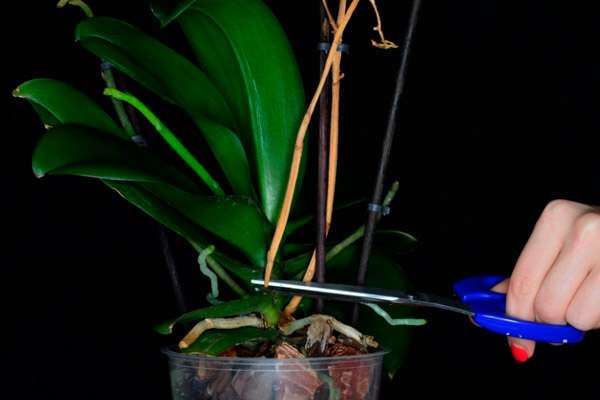

The dried stalks of orchids are cut off.
Prevention of diseases and pests
Cambria - fairly resistant to disease plant. Of course, diseases do happen, but the main ones are associated with the consequences of improper care or an unhealthy orchid acquired.
Therefore, preventive measures are mainly related to the creation of the required conditions and adequate care. Also, a plant bought in a store should be quarantined for a while and treated with drugs from pests or any diseases that may be in it.
Experienced florists recommend carrying out preventive treatments every six months biofungicides.
Can flowers be fertilized?
The cambria orchid responds very well to organic feeding. But you need to fertilize only in a certain period, dosed.
Basic feeding rules:
- The right time to apply the fertilizer dose is during the development of young leaves, flower stalks and buds.
- As soon as flowering begins, top dressing is excluded.
- To prevent chemical burns of sensitive roots, the recommended dose is halved and diluted with the specified amount of prepared water.
- It is not worth fertilizing the plant very often, the most optimal scheme is that ordinary watering alternates with watering with the addition of organic elements.
- While the pseudobulb is forming, it accumulates all the necessary substances for flowering, therefore, during flowering, the cambrian does not need additional feeding.
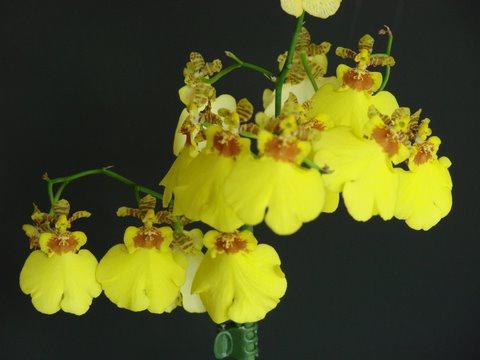

Landing
Soil selection
The structure of the soil for this type of orchid should be light enough... Ordinary potting soil is unacceptable for her. Ready-made soil "For Orchids" or as it is correctly called - the substrate, can be purchased in flower shops or centers.
When preparing the substrate yourself, you will need:
- tree bark. The best is considered to be roasted in the oven or boiled pine bark, with a fraction of 1-1.5 cm;
- charcoal;
- sphagnum moss;
- inert components serving as drainage.
Inert components are combined depending on the humidity in the room. And the breathability to the root is increased with coconut chips or small pieces of foam.
Important! The quality and composition of the substrate is the basis for full development and flowering.
Capacity
Cumbria roots do not participate in photosynthesis, therefore no transparent container required for growing... Experienced orchid growers generally use opaque plastic or clay flower containers.
The most thick-walled unglazed ceramics are considered ideal... It allows air to pass through well, maintains a constant temperature regime inside the pot. In the heat, it provides coolness for the root part, and in the cold season, it keeps it from hypothermia.
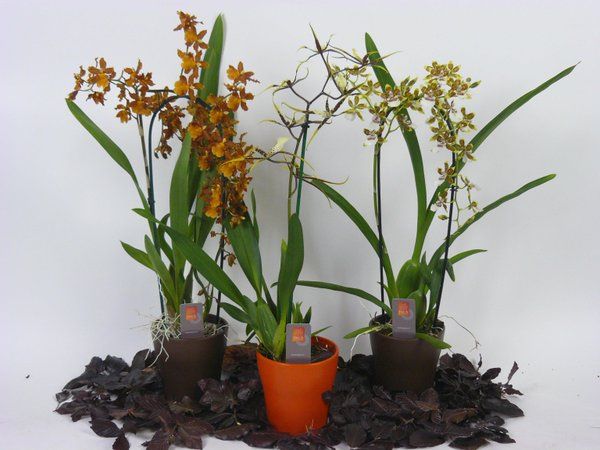

Thick-walled ceramic pots are suitable for Cumbria.
Timing and technology
Almost all plants are stressed during transplanting. Orchid plants are no exception. The replanting frequency for Cambria is every two to three years... This is mainly due to the period of decomposition of the components of the substrate. It is ideal to carry out the transplanting procedure immediately after flowering.
Unplanned, emergency transplant is carried out in cases:
- decay of the root system;
- a large number of bulbs on the surface;
- soil salinity;
- the substrate has caked or turned into dust;
- a large number of roots on the surface - the roots are cramped;
- the purchased plant does not bloom for a long time.
A new container with a diameter 2-3 cm wider than the previous one is selected.
Can you transplant during flowering?
On the Internet you can see a photo of the transplant, but this is not recommended. During the flowering period, all the energy of the plant is aimed at obtaining offspring and interrupting the process interrupts the life cycle. therefore it is better to transplant only after flowering.
But with prolonged flowering, a situation may arise that the plant continues to grow and the root system becomes very cramped in the pot and it gets out. In this case, experienced florists carry out a transplant, but such an operation is very delicate and meticulous.
Thin roots, like capillaries receiving nourishment, break off easily. It can be transplanted very carefully by the transfer method, without disturbing the substrate lump of the root part. For beginners, it is better not to carry out such a procedure. And, of course, you can transplant during the flowering period while observing diseases of the root system.
Do I need to transplant cambria?
After the beautiful representative of the tropical flora has been on your windowsill for one or two years, she needs to change the pot and substrate. Since during this time he was saturated with the remnants of minerals, which are oxidized over time. In addition, soil fragments can overheat and crumble. Another reason is the increase in root volume. They grew up and no longer fit in a pot.


Resuscitation of the Cumbria orchid without roots
It happens, especially for beginners with improper care, that the root system of the orchid suffers or even decays. This often happens as a result of waterlogging of the substrate. Throwing it away and worrying about this is not worth it, since the plant can be restored.
It should be removed from the container and decayed roots cut off. Treat the whole plant with Fundazol and fix it on a new substrate, consisting of pine bark and small pieces of foam, using some kind of device.
At the same time, it is not necessary to water the orchid, only 1-2 a week to spray on the leaf, like a "foggy cloud". The leaves are covered with such a cloud so that drops do not run down them. Periodically, at every third spraying, spray with Fundazole solution instead of water.
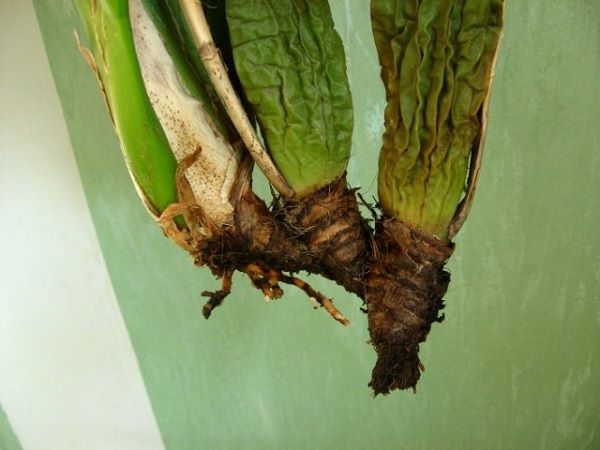

Even in the absence of roots, Cambria can be reanimated.
The emergence of new roots is a rather long process. Patience and proper care will work well and the orchid will not die. The main thing is not to make mistakes in the future.
When is the best time to transplant?
Orchid transplantation (cambria in this case is the subject of our conversation) is carried out at the moment when new roots on the pseudobulb are just about to appear. Pick a pot made of opaque plastic or ceramic slightly larger than the previous one and prepare the soil. A ready-made substrate for orchids or chopped pine bark is suitable.
Further actions are performed according to the following algorithm:
- The plant is carefully removed from the old pot.
- The roots are cleaned of soil residues and carefully examined.
- Sick, dried or rotten roots are cut with a sharp knife and sprinkled with charcoal.
- A drain or a larger piece of bark can be placed at the bottom of the new pot to improve air circulation.
- Next, the plant is placed in a pot and the roots are carefully sprinkled with new soil.
- Please note: Bulbs should not be covered from above.
The transplanted orchid does not need to be watered for a week.
Major diseases and their treatment
Yellowing and lethargy of leaves
One of the most common problems not only for Cumbria. There are plenty of reasons:
- lack of lighting;
- direct sunlight;
- root system problems - fungal infections;
- lack of nutrition;
- insufficient watering;
- hypothermia;
- natural leaf shedding process.
Treatment and prevention is based on proper and proper care and the creation of an acceptable environment.
Black dots on the leaves
If the points do not spread and with good turgor of the leaves, the points are not on all foliage, then in principle, there is nothing wrong.
But it's worth taking care. Perhaps some kind of fungal disease and it is better to treat it with a fungicide.
Dark spots may appear due to sunburn after spraying. Cambria doesn't like spraying.
Roots rotted
With complete or partial decay of the root system, a transplant or resuscitation measures are necessary. And the sooner this is done, the sooner the orchid will recover and not die.
The main cause of root rot is improper watering and waterlogging of the soil.
Dry rot on the bulb
Bulb decay is associated either with deep planting of orchids, or with the ingress of water on them... They should be removed. If necessary, transplant the plant and water it correctly, avoiding moisture.
Bulbs shriveled
Pseudobulb wrinkling, mainly associated with possible root drying due to insufficient watering. It is necessary to organize watering by immersion and prevent moisture from entering the axils of the leaves.
Often the reason is finding snails in the substrate... Then a transplant is required.


Shriveled bulb.
How often should you water?
Watering these flowers has several features.
- Its frequency depends on the formation of pseudobulbs. Until the cambria (orchid of any variety or hybrid) has formed a pseudobulb near the base, it requires abundant and frequent watering. But as soon as it is fully formed, it is necessary to take a break of up to three weeks between waterings. So you can achieve the appearance of a new peduncle. As soon as it starts to grow, watering is resumed.
- Like other types of these tropical plants, orchids should not be watered or left in water for long periods of time. They need to be immersed for half an hour in prepared water about once a week. The soil should dry out between waterings. In winter, watering can also be done once every two weeks due to a decrease in temperature and a decrease in the level of moisture evaporation.
- Regular tap water will not work for irrigation purposes. It should be at least filtered or separated. Moreover, it is worth knowing that the plant gets used to certain water and reacts sharply to a change in its quality.
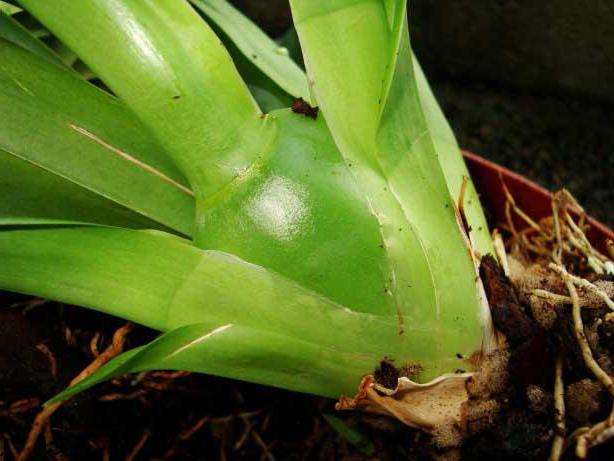

- Recommendation: do not let water get on the pseudobulb to exclude the possibility of its rotting.
Reproduction methods at home
Dividing the bush
Reproduction of orchids - very exciting experience. If you have some knowledge, then this process does not pose a particular risk and almost always ends successfully.
Sympodial cambria always form at least two buds at the base of the pseudobulbs. For reproduction, it is better to use a healthy plant with 3-4 divisions. The bush is carefully divided so that each part has at least 3 pseudobulbs. The incision is made carefully to avoid root damage.
Important! The sections are treated with crushed activated carbon and then dried.
Then the prepared material is planted in a new substrate from the bark. Watering is carried out only after 7-10 days, and feeding is carried out at least after a month. Delenki are fixed with pegs and shaded a little.
The plant does not bloom. What to do?
Typically varietal cambrias bloom once a year. Duration of flowering is from three to seven weeks. If your cambria orchid has faded, care for it needs to be strengthened. Dry peduncles are cut off, the period of feeding and drying begins.That is, the orchid continues to be watered as usual, with the addition of fertilizers to the water until the process of forming a new pseudobulb is completed. Once this process is over, the plant is not watered altogether for two to three weeks. During this time, flower stalks are formed, which soon appear from the base of the bulb. The dormant period and growth of a new bulb in total can be about 10 months.
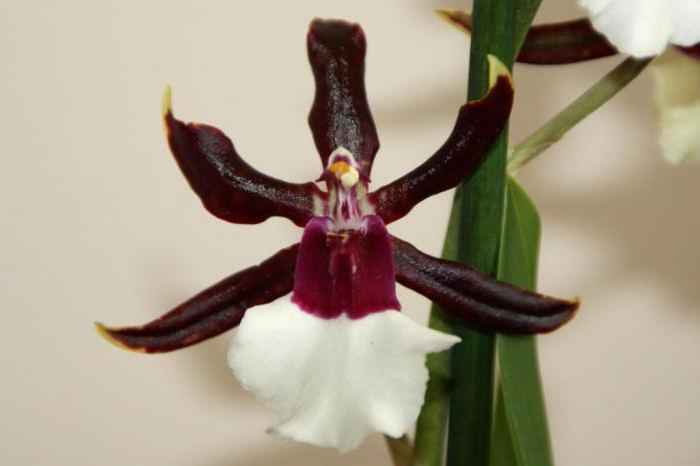

The beauty of Cambria feels great at home and can bloom for more than one year. The main thing is to comply with the specified conditions of agricultural technology.
When do you need a cambria transplant?
Caring for cambria at home involves a transplant. The plant does not like when it is disturbed for no reason, it likes small pots - maximum roots and minimum substrate.
There are several reasons for the transplant:
- unsuitable substrate - salted with minerals, sour, caked;
- problems with the root system;
- the orchid has outgrown the pot - the bulbs have nowhere to grow;
- the desire to divide the overgrown bush.
The substrate for planting is the same as for phalaenopsis. Large pieces are placed on the bottom, small pieces are covered on top. Plastic, earthenware pots are suitable, there are special ones - with side holes for air circulation.
The optimal time for transplanting is the beginning of growth, when the new shoot has reached 5–7 cm and began to grow roots.
Table: care errors and options for their solution
| Problem | Cause | What to do? |
| A new bulb appears instead of a peduncle | Excessive hydration. | Stop watering for a few days and dry the soil. |
| Bulb decay |
|
|
| Leaves turn yellow |
| Move the flower to another place or shade it from the sun. |
| Spots on the leaves |
|
|
| Cambria grows "ladder" | This is typical for some plant species. Or Cumbria doesn't have enough potting space. |
|
| Shriveled or dark bulbs |
|
|
| White bloom on leaves and stems |
|
|
| Leaves are bright green | Lack of light. | Move the flower to a more illuminated place |
| Leaves are collected in an accordion | Insufficient air humidity. | Increase moisture around the plant, spray more often. But watering should not be increased, otherwise the roots will rot. |
| Cumbria roots darken, when pressed, liquid is released from them (this can be seen, since often the roots are located on top of the soil) |
|
|
Resuscitation of Cumbria without roots
If Cambria has lost its roots (for example, they have rotted due to waterlogging or acidification of the substrate), you can try to save the plant.
- Cut off all rotten roots and leave to air dry for several hours.
- Then place the plant in a fresh mixture of bark and coal, provide the necessary lighting (at least 8 hours of daylight hours) and spray often, adding once a week a weak Epin solution (1 ml per 7 liters of water).
- Since the plant has no support, it is worth helping it - put a stick next to it and tie it with a thread. After a while, young bulbs should give roots.


This is how you can reanimate Cambria, which has lost its roots.
Everyone knows that orchids take root well in water. But Cumbria is an exception. You can go the other way: fix the plant, which has lost its roots, above the water surface, excluding the contact of the base with the liquid surface. The wait will be short and when roots appear, anchor the plant on a piece of bark and spray.
Video: how to grow the roots of Cumbria
When and how to fertilize the plant
Cumbria should be fed during the growing season and stop feeding when flowering begins. Fertilize the flower with preparations intended for orchids, reducing the concentration by half from the indicated, so as not to burn the sensitive root system. To make top dressing, you need to water Cambria with water with the addition of diluted fertilizers, alternating with regular watering. The orchid reacts well to organics. During the formation of a pseudobulb, fertilizers are not needed.
Bloom
Cambria flower blooms in late autumn or early winter. It blooms for 30-45 days. Caring for Cambria during the flowering period includes:
- providing additional lighting;
- correct irrigation regime.
If bulbs are forming instead of flowers, which is the reason why Cambria is not blooming, you need to stimulate the bloom. To do this, watering should be reduced, and when the bulbs are formed, do not water the orchid for 15 days. After that, the soil should be moistened and left without water again. Such drying contributes to the formation of a peduncle, after which watering is returned to normal.
After flowering, you can stimulate a second one, leaving Cambria without rest. Or let the flower retire, while reducing the amount of watering, stopping fertilization and placing it in a cooler place. It is important that the air temperature does not drop below +14 degrees, but remains at + 16-18.
In order for the flowering to last throughout the year, you need to let the orchid grow. On a larger bush, a larger number of peduncles are formed, which contributes to an abundant and long-lasting flowering. Getting Cambria to bloom requires proper care.
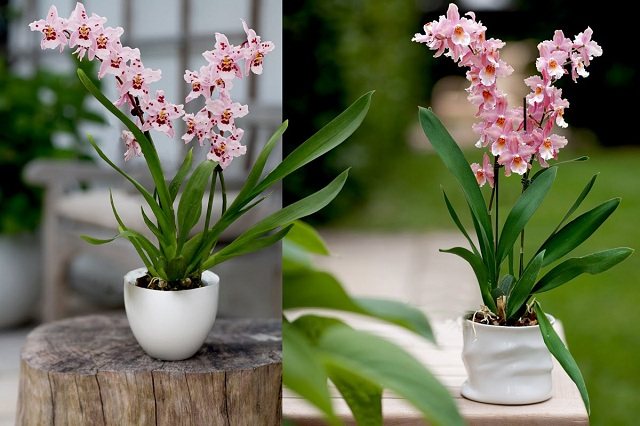

Main varieties
The Cambrian species is divided into many varieties. Below are the most popular ones.
Colmanara
The orchid is obtained by combining 3 species. Shoots stretch up to 50 cm. Flowers are characterized by a variety of shapes and colors.
Wuilstekeara
The variety is notable for its long flowering shoots, on which there are 5-20 large flowers of yellow, dark red, light red color. The plant blooms for two months. Flowering begins at the end of winter.
Burrageara
A hybrid with large red flowers obtained by combining 4 species.
Beallara
The variety, created by combining 4 species, is notable for its variegated star-shaped flowers.
Degarmoara
Shoots grow up to 10 cm. Flowers are characterized by a variety of shapes and colors. Flowering occurs year-round.


Odontocidium
Long flowering shoots produce up to 50 small flowers. The color is variegated, different shades of red and yellow prevail. Blooming all year round.
Odontioda
Variety with yellow-red flowers. Blooms all year round.
Orchid bloom
Vanilla Orchid: the main types and options for home care
The orchid blooms for 5-7 weeks. After that, the dried peduncle is necessarily removed. Caring for a fading orchid, it is necessary to be able to properly prune the cambria of the peduncle. It is important that after a while the flower can continue its flowering or grow babies from the waiting buds.
Note! It is necessary to cut off the peduncle only when the green branch begins to turn yellow or red.
Possible difficulties
The main problem with growing cambria, which almost all hobbyists face, is that the flower does not bloom from year to year. The reason for this behavior in cambria is considered to be excessive moisture supplied to the plant during the formation of pseudobulbs. This is what prevents flower buds from forming. Therefore, in order for Cambria to bloom annually at home, it is necessary to carefully monitor the flow of moisture.
General information
The first representative of the cambrian orchid was bred in the 20th century in the UK.
When creating, the following types of orchids were crossed:
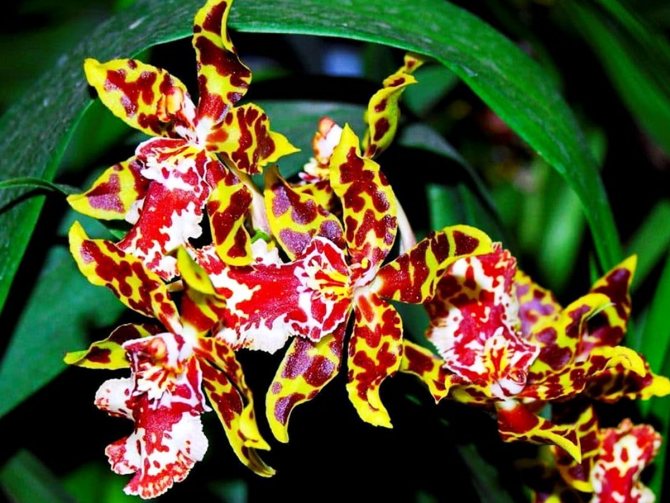

Oncidium
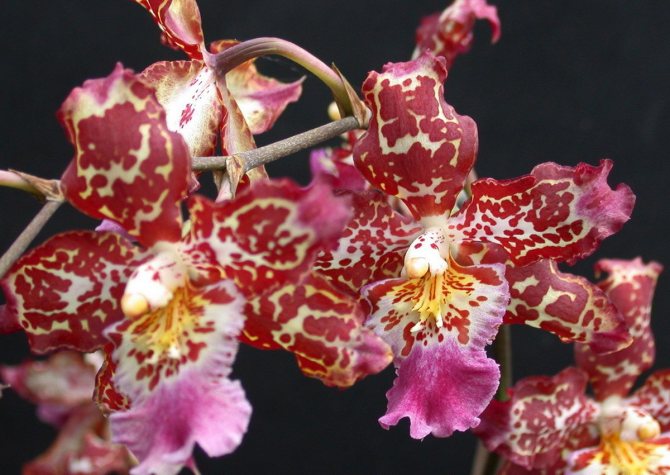

Odnotoglossum
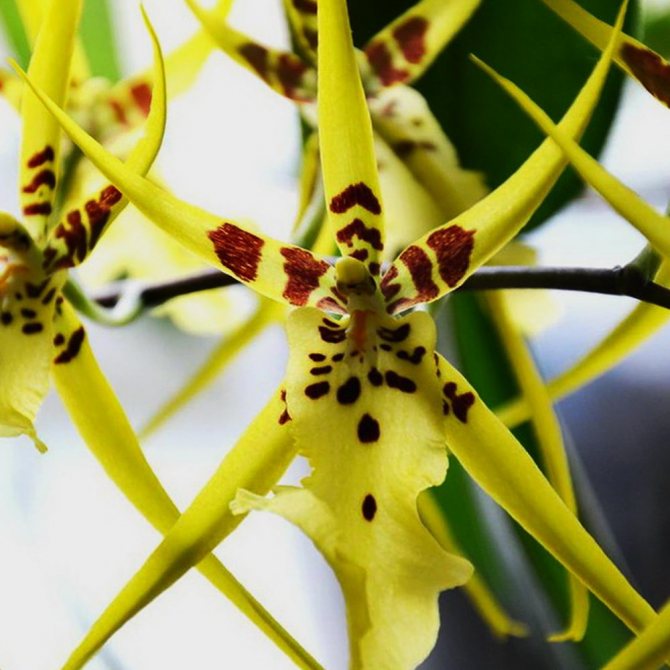

Brassia
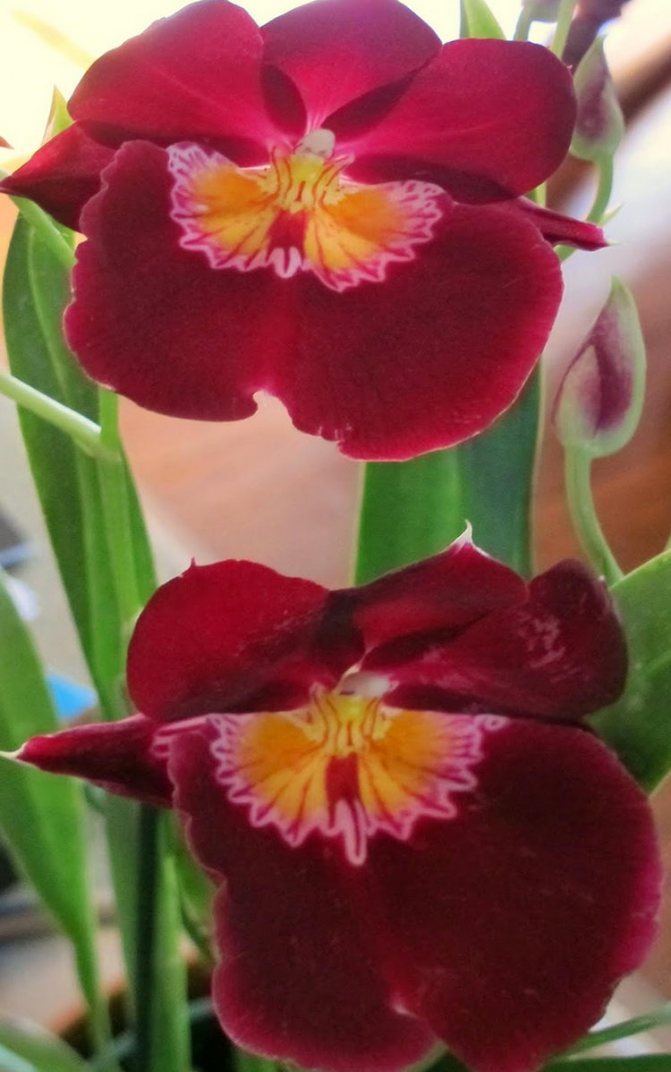

Miltonia
On the basis of the first representative, many varieties of the Cumbria genus were additionally bred, the most common are as follows:
|
|
Flowering in cambria occurs 1 time in about 9-10 months, regardless of the season. The flowers are bright and last for a long time - up to 7 weeks.
At the end of flowering, the cambria releases a false bulb, which releases a peduncle the next year.
How to reproduce?
The main breeding method is dividing the bush. Its technology:
- Prepare the substrate and pots in advance.
- Disinfect containers in potassium permanganate.
- Moisten the soil, remove the plant from the pot.
- Remove soil from the roots.
- Divide the root system so that each young plant has at least three pseudobulbs.
- Plant them in new pots.
Attention! Young orchids are not watered for the first 10 days after the procedure.
Properly organized care will allow you to grow a beautiful, luxuriantly flowering plant. Cumbria is worth adding to your pet collection.
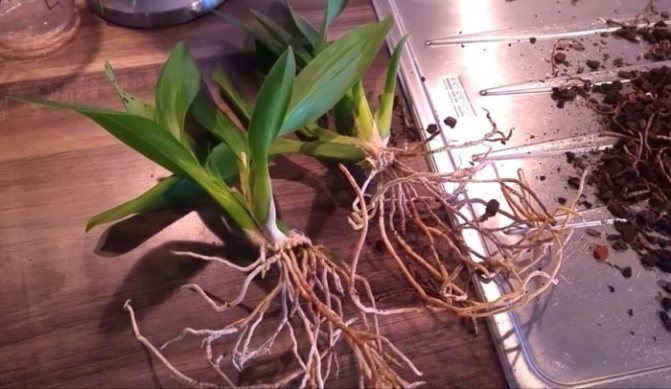

5 / 5 ( 1 vote)
Description of flowers, leaves and bulbs of cambria, specifics of flowering
The compact size of the plant, the richness of the appearance of this flower rightfully brought it wide popularity and the love of many who grow their favorites on windowsills. Both a seasoned gardener and a beginner will cope with them - it is enough to familiarize yourself with the specifics of the varieties and the recommendations of specialists regarding care
It is quite simple to give a description of the cambria orchid, since this plant has a unique appearance and attracts with bright colors. It is found in various colors, the most common of which are purple, yellow, burgundy. The petals of this flower have a long and narrow shape, just like the leaves, but the flower itself is more "figured": the edges of the petal are uneven, often curved and even somewhat wavy. Due to this, the orchid was also nicknamed the "star".
The plant can be recognized by the rounded pseudobulbs visible on top of the soil, and the shoot type of growth.
Cambrian leaves are up to half a meter in length. From each bulb, 2-3 narrow elongated leaves grow, rather dense and sinewy to the touch. Some experts advise wiping the leaves with a damp cloth. Direct sunlight is harmful to this plant, which can cause burns. The appearance of an unhealthy yellowish color or black spots indicates a flower disease.
The flowers of the cambria are often quite large and, as already mentioned, quite varied in appearance. They can have more rounded petals and narrower ones, but for the most part, in general, they resemble the shape of a starfish. In diameter, they reach about 10 cm, and the smallest - 50 mm, germinate on peduncles in "groups". By color, the most common are:
- Purple.
- Cream.
- Scarlet.
- Red.
These flowers are quite rarely monochromatic, which is the specificity of the cambrian flowering: often the petals are stained with two colors at once and are noticeable with a characteristic interspersed with white spots or stripes, a bright yellow core. With proper care, flowering can occur several times a year.Nevertheless, the plant also has a hibernation period: the flower is placed in a cool, dark place for several weeks. At this time, flowering stops and gives the hybrid a rest.
Difficulties in growing
If the appearance of the flower does not match the state of a healthy plant, in most cases the reason lies in inappropriate care. The problem is either improper watering or a lack of lighting. To find the cause of the poor condition of the plant, you need to change the usual care and fertilizers that are applied to the soil.
If the leaves turn yellow, the root system decays. This situation occurs when water is stagnant in the ground. Excess moisture is a favorable environment for the reproduction of pathogenic microorganisms (fungus). As soon as the flower or leaf turns yellow, you need to dry the plant well. For this, the plant is taken out of the pot and left in a dry room for a day. Before transplanting, the plant is treated with fungicide: only after treatment, the root system returns to the substrate.
If the dry leaves are too damaged, they must be removed. If the soil is lacking in nutrients, yellow spots may also appear. In this case, the situation will improve if you change the nutrients. If the culture sheds yellowed leaves in the autumn, this is a normal phenomenon necessary for the renewal of the green part of the plant. Yellow spots may appear due to sunburn. In this case, the orchid pot needs to be moved to another location.
Solving common growing problems
Inexperienced growers, when growing cambrian orchids, are faced with many problems, which must be eliminated immediately so as not to destroy the plant.
Care errors
Many problems are associated with non-compliance with the rules of flower care.
Pseudobulbs frown
This is due to a lack of moisture or rotting of the root system. In the first case, it is necessary to normalize the irrigation regime, in the second, to remove the plant from the substrate, remove rotten roots.
Ladder growth
This is a sign that there is not enough room for roots in the pot. Transplanting into a larger pot is required. To support the above-ground part, a support is placed.
Pseudobulb cracking
The problem is in the overflow of the substrate at low temperatures and lack of lighting. The solution is to normalize the illumination level, temperature indicators and irrigation regime.
Leaves turn white, thicken or change color
This usually happens with excessive feeding. Cambria is extremely sensitive to excess nutrients. Therefore, fertilizers are used carefully, a weakly concentrated solution is made.
Yellow foliage
The problem is related to the direct hit of ultraviolet rays on the sheet plates. Shading required. The plant is rearranged in a place where the lighting is diffused.
Pests
Most often, cambria suffers from attacks by ticks, aphids and scale insects.
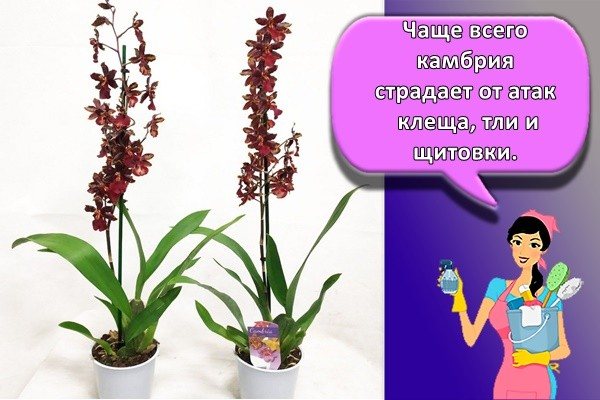

Spider mite
Signs of damage - a cobweb on the underside of the leaf plates, dark dots on the leaves. Treatment consists in using strong insecticides - Fitoverm, Actellik, Confidor. To prevent tick damage, the plant is periodically treated with a mild soapy solution.
See also
Step-by-step instructions for caring for orchids at home
Shield
Symptom - covering the surface of the stems with small brown plaques. Insects are removed from the shoots by hand with a cotton swab, wiped with soapy water. Insecticides are of little help, since adult pests are protected from external influences by a shell.
Aphid
Small insects suck the juices out of the plant, slowing down its development. An effective means of control and prevention is a soap solution. In an advanced case, insecticides are used. Aphids do not like citrus scent, so you can put lemon or orange peels on the surface of the substrate. For prevention, it is important to maintain optimal air humidity.
Diseases
With poor quality and unsystematic care, cambria gets sick.
Anthracnose
Fungal disease that occurs with excess moisture and lack of ventilation. Symptom - spots on the leaves that grow, darken, then become covered with a pinkish bloom. Fight infection with fungicides. For prophylaxis, the room is regularly ventilated, the accumulated liquid is removed from the leaf sinuses after spraying with a cotton swab or napkin.
Powdery mildew
Fungal disease, accompanied by the appearance of a whitish plaque on the leaf plates, occurs with excessive moisture. Fungicides are used to fight the fungus. If untreated, the plant dies.
Rust
A dangerous fungal infection in which the leaves are covered with red spots. The diseased parts of the plant are cut off. Places of cuts are treated with 25% alcohol. Treat the infection with fungicides Skor, Ridomil.
Resuscitation of an orchid without roots
Cambria is one of those species that can be saved even after all the roots have died. The dying plant is removed from the substrate, the decayed roots are cut off, the sections are treated with crushed coal.


The orchid is placed in a container of water, into which a root growth stimulator is added according to the instructions. When the first roots appear, the plant is planted in a nutritious soil.
Table: Conditions for keeping at home
| Season | Lighting | Humidity | Temperature |
| Spring | Even on the north side, Cambria will feel good. To bloom more luxuriantly, Cumbria needs diffused, but bright light, so a window sill on the west or east side will be the best place for it. A south-facing window, which is more illuminated than others, is ideal. In spring and summer, the plant should be hidden behind a curtain from the bright sun. This is especially true for hybrids with thin and soft leaves. | Cumbria are not so demanding on the level of air humidity. 25-30% is a sufficient indicator. But during the growth of young pseudobulbs, the humidity in the room should be raised to 40-50%. If the temperature in the room with the plant does not exceed 18 ° C, then you should not additionally moisten the flower. In the summer heat and with the central heating operating, you can spray the air around Cumbria or place the pot on a flat plate with a dampened filler. You need to spray the flower very carefully and only from a fine spray. Do not let the water run down the orchid - this can lead to decay. It is strictly forbidden to put a plant under the shower! | Cambria is a lover of moderate temperatures. Hybrids do well at 15–25 ° C. At very high temperatures, cambria can stop growing. Therefore, preference should be given to a cool room rather than a warm one. In such conditions, the plant develops better. |
| Summer | |||
| Fall | In the cold season, Cambria must be provided with additional lighting. | Winter temperature regime - from 16 to 18 ° С. | |
| Winter |
In summer, the flower feels great in the fresh air. In the garden or on the balcony, a secluded spot is suitable for Cumbria, protected from wind, rain and direct sunlight. In indoor conditions, the flower requires good air circulation, but is afraid of drafts.
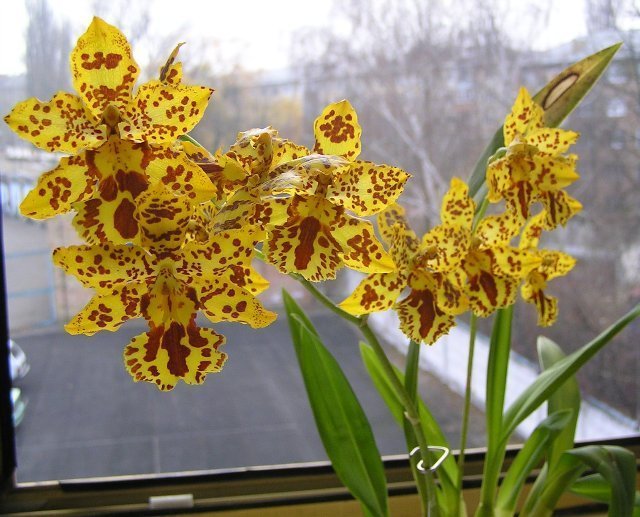

Bright, diffused light is essential for Cumbria
Cambria flowering: proper care during flowering
The Asterisk Orchid pleases those around it with flowering closer to winter, therefore it needs additional lighting. The average flowering period of the species is just over a month. The plant then begins to form new bulbs. A year later, the peduncle appears again. If, instead of flowering, a new bulb is born, you should change the watering mode.
The stimulus for flowering will be the so-called "drying". Reduce watering during the growth of pseudobulbs, after their formation, abandon watering for two weeks, then moisten the substrate and let it stand again without water. This will force Cambria to discard the flower stalk, and then the usual watering procedure can be restored.
Common problems
Fungal diseases and various types of rot arise from a large amount of moisture on the roots, and bacterial infections are manifested by sucking pests. If the leaves turn yellow, this means that the orchid is sick and follows:
- pull it out of the pot;
- leave in a dry place for the whole day;
- dry the roots;
- apply fertilizer;
- transplant the orchid into new soil, after the roots have completely dried.


If the leaves turn yellow, then this is affected by the lack of nutrients in the soil, and the plant begins to shed old leaves.
Care for the Cumbria orchid must be carried out correctly and constantly, otherwise diseases and other pests will appear on the flower:
- Powdery mildew. This disease manifests itself on the leaf in the form of a white bloom. The reason for the appearance is frequent watering. If the flower is not treated, then over time it will die. For treatment, use an insecticide Skor.
- Rust. This disease damages the leaves of the flower. Orange-red spots appear on its inner side, and to get rid of them, you need to use a clerical knife. After that, the trimmed areas should be treated with 25 percent alcohol. For treatment, use Skor, Ridomil and Mikosan.
- Anthracnose. At the very beginning of the disease, small spots appear on the leaves of the orchid. Over time, they turn black, taking on a concave shape. After that, a bloom of yellow or pink appears on the spots. The reason for the appearance is waterlogging. To prevent the appearance of this infection, you need to often ventilate the room, as well as wipe the leaf sinuses from excess water. Use insecticides for treatment.
- Black dots on the leaves of Cumbria. This infection belongs to bacterial diseases. Bacteria that have settled on a flower destroy it if you do not take treatment. Remove the affected areas, and spray the plant with a fungicide. Then put Cambria in a lighted place.
The most common pests on Cumbria are the scale insect and aphids, but the most dangerous is the scale insect, which causes the plant to die. The reason for the appearance is inadequate care of Cambria. If a pest has appeared, then the flower must be sprayed with soapy water and applied with insecticides. Preventive measures should be carried out at the expense of a product based on the oil of the Neem tree.
Resuscitation of Cumbria without roots was made possible by the efforts of breeders. In order for her to survive, she needs to be given special care. To do this, lower the flower into water, with a growth stimulant diluted in it. This promotes better root growth. When the first roots appear, the orchid can be planted in the soil.
If there is a mini-greenhouse, then it is also used for the Cumbria orchid. Roots are grown on the bark, to which the flower is attached, and then placed inside the greenhouse. It is possible to grow roots in it faster, but for this you need to ventilate it.
Growing roots in water is prohibited. This method of saving Cumbria is suitable for other varieties of orchids, but if Cumbria is without roots, then it can be attached to the bark above the water and wait for the first roots to appear.
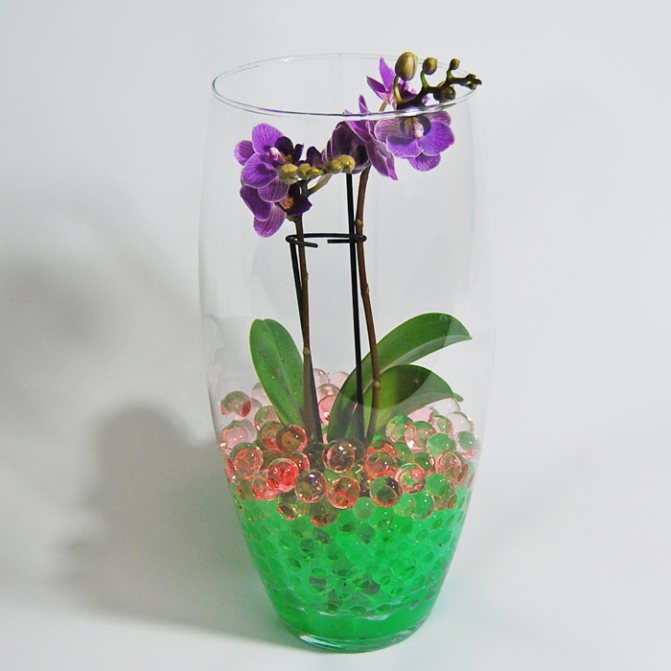

You may be interested in:
Orchid in a hydrogel: planting, growing and care Orchid is a decorative flower that appeared on windowsills not so long ago. Among the various species, the most ... Read more ...
Prevention of various problems
- Yellowed leaves of a plant may appear due to excess or lack of moisture or light.
- Shriveled bulb - due to a lack of moisture or parasites that have appeared in the soil of the plant, transplanting will help.
- If the roots have rotted, an urgent flower transplant is needed.
- With black dots on the leaves, it is also worth treating Cumbria with a fungicide solution.
Although the Cambria Orchid is not so whimsical, you should not start this plant without the necessary experience and care at home.
If you find an error, please select a piece of text and press Ctrl + Enter.
Bulbs and pseudobulbs
Bulbs are called tubers located underground, like potatoes. Orchids have pseudobulbs.They are called differently: tuberidia, aerial or aerial tubers. They got this name due to the fact that they are above the earth.
They also differ in color from ordinary bulbs, they are usually green. The size of the tuberidia varies depending on the types of orchids: they can be very small, and they can grow up to 15 cm. The shape of pseudobulbs is different - elongated, round, spherical.
Photo
Next, you can see the photos and names of the Cambria orchid, as well as other types of flower:
"Colmanara"
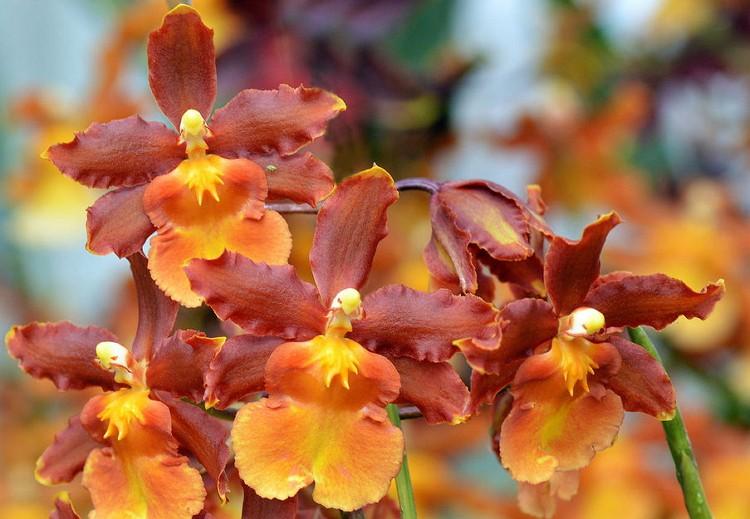

"Belara"
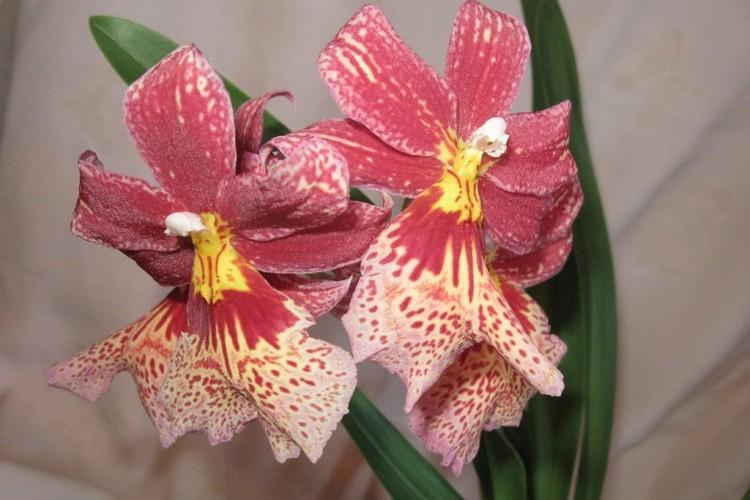

"Miltassia"


"Burrageara"


Flowering plant
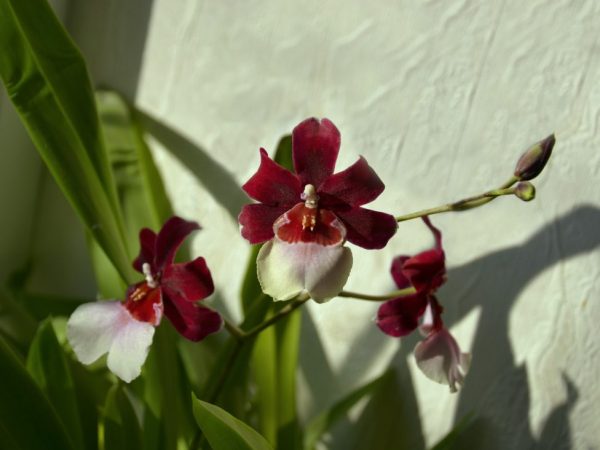

Cambria blooms in good light
Cumbria bloom in the middle of autumn. If crops have little light, they bloom closer to winter. After the appearance of the first inflorescences, lighting improves - this is a prerequisite for the further development of the orchid. If the plants do not bloom for more than 2 years, their growth is stimulated: watering is reduced during the formation of a pseudobulb. After that, watering does not resume for another 2 weeks.
Post-flowering care
You need to be careful with an orchid after flowering: the plant is weak and often sick. Water the hybrid less as soon as the last petals fall. During this period, you can move the pot (if the inflorescence has not fallen, it is better not to move it). The winter content of the flower is minimal: watering and airing the room.
Planting and transplanting
In stores, a temporary substrate is usually used, therefore, after purchase, it is advisable to transplant the flower into high-quality soil. But you should not do this right away, let the cambria stand for a couple of weeks, adapting to new conditions. Cambria does not like transplants, it is a lot of stress for her. Therefore, the orchid is transplanted no more than once every 3-4 years. But you cannot do without transplants: firstly, the soil loses nutrients, and secondly, the roots grow, begin to bulge out of the drainage holes.
For transplantation, take a plastic or ceramic pot, but opaque. Unlike other orchids, Cambria does not tolerate sunlight on its roots. The new pot should be a couple of centimeters larger than the old one. The pseudobulbs of the transplanted orchid are not sprinkled with soil. The plant is left alone for a while. Watering after transplanting is resumed a week later.


How to propagate?
Cambria is usually propagated by dividing the bush, it is best to do this in the spring, when the dormant period ends and the active growth phase begins. It is quite possible to successfully combine the reproduction procedure with a transplant, because reproduction is also best after flowering. Let's take a look at the main steps:
- first of all, we soak the root system in water (immersion) so that fragile roots are not damaged;
- we process tools with alcohol;
- we remove spoiled (rotten) places;
- carefully divide the plant into 2-3 parts;
- we treat places of damage and cut leaves with coal powder;
- we remove the old soil from the root and dry it;
- we plant the plants in new soil.
Watch a video about the reproduction of an orchid by dividing a bush:
Reproduction
The cambrian orchid is propagated by dividing the plant or by children.
Dividing the bush
The procedure is carried out when transplanting a plant. They act according to the following algorithm:
- the plant is removed from the pot, the soil lump is shaken off;
- the roots are examined, the sick and rotten ones are cut off;
- the plant is divided in half or into more parts;
- slices are lubricated with charcoal or manganese solution;
- each flower is planted in a separate container.
Children
The resulting shoots, as soon as several leaves grow on them, are separated from the mother plant. Children are placed in water in which a root growth stimulant is dissolved. After the roots appear, young plants are planted in pots.
How to deal with diseases and pests
With improper care and favorable conditions for the activity of pests and diseases, the owners of Cumbria can face a number of problems.
Table: why do watery spots appear, leaves turn yellow, bulbs rot?
| Diseases / pests | Signs | Control measures and prevention |
| Fungal diseases | Whitish or gray bloom on the plant, the appearance of spots on the leaves. |
|
| Bacterial infections | Rotting roots and bulbs, darkening and dying off of leaves, the appearance of dark spots on leaves and bulbs. The stains can be wet and give off an unpleasant odor. |
|
| Orchid aphid | Aphids densely stick to peduncles and young growths. It feeds on plant juices. |
|
| Shields | Insects, similar to convex tubercles, appear in the axils of the leaves and on their surface. They feed on plant juices, emitting a dense liquid, which becomes a breeding ground for the sooty fungus. |
|
| Thrips | Signs of the appearance of thrips are many dark dots on the leaves and a silvery film. Small insects lay their eggs in leaf tissue. The larvae then feed on the leaf cells. All parts of the plant are affected by thrips. |
|
| Snails | Snails can live in the substrate and remain undetected for a long time. At night they climb on young shoots, feed on them. You can detect it by noticing the silvery trail that the snail leaves. |
|
Photo gallery: pests and diseases of orchids


Fungal and bacterial diseases lead to the defeat of all parts of the plant
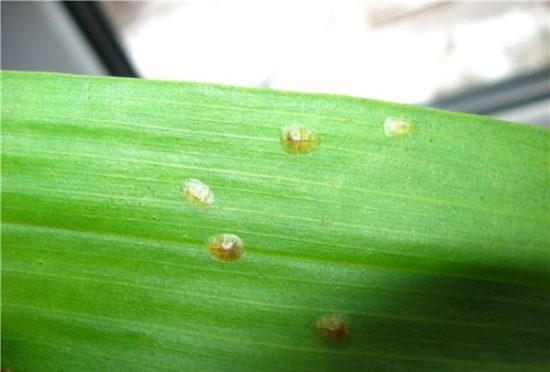

Scabbards look like bulging tubercles on the leaves.


Orchid aphids stick around young leaves


Thrips lay eggs in leaf tissue Snail can be detected by the remaining silvery trail
The best varieties
Plush - with scarlet petals and sepals. The lip is large, scarlet to the middle, its lower part is snow-white with miniature purple peas. Several bright yellow intermittent thin stripes stretch from the pharynx along the lip.
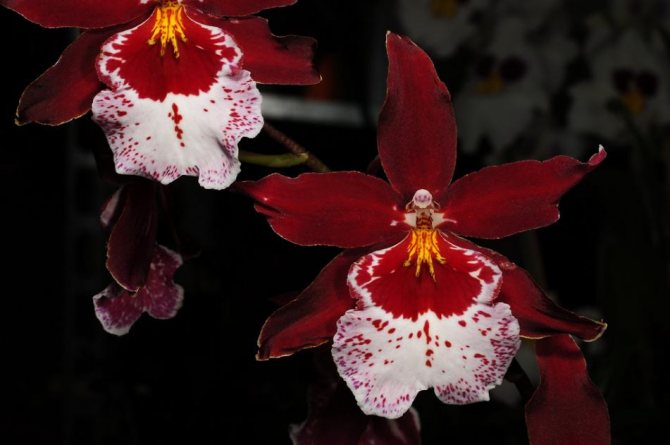

Nelly Isler - crimson petals, small light specks are scattered at their very tops. The lip is of impressive size, its size exceeds sepals and petals, and is spotty up to the middle. Near the throat itself, a square-shaped spot is crossed diagonally crossed by lines of the color of the main background.
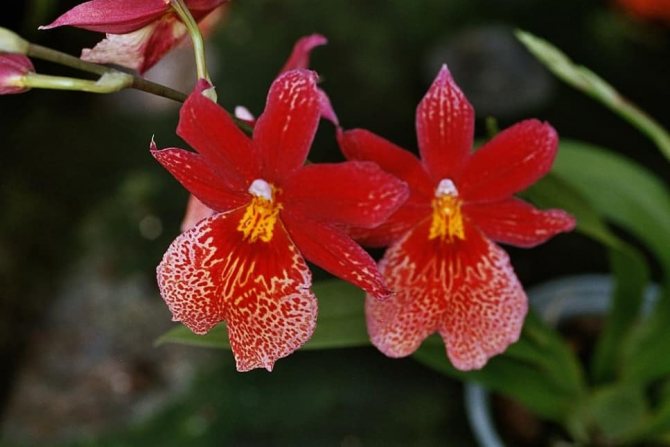

Bartley Schwarz - the lip is snow-white, two-lobed, the petals are deep red. The flower exudes a very delicate and pleasant aroma.
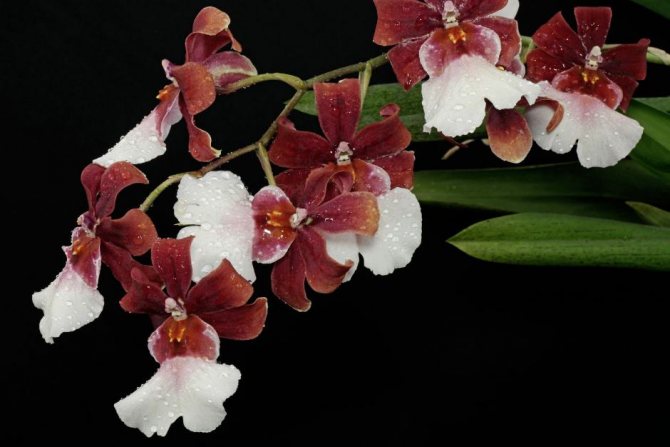

Eurostar - star-shaped flowers with long pointed petals of a dull crimson color. Leaves are thin and flexible, break easily.
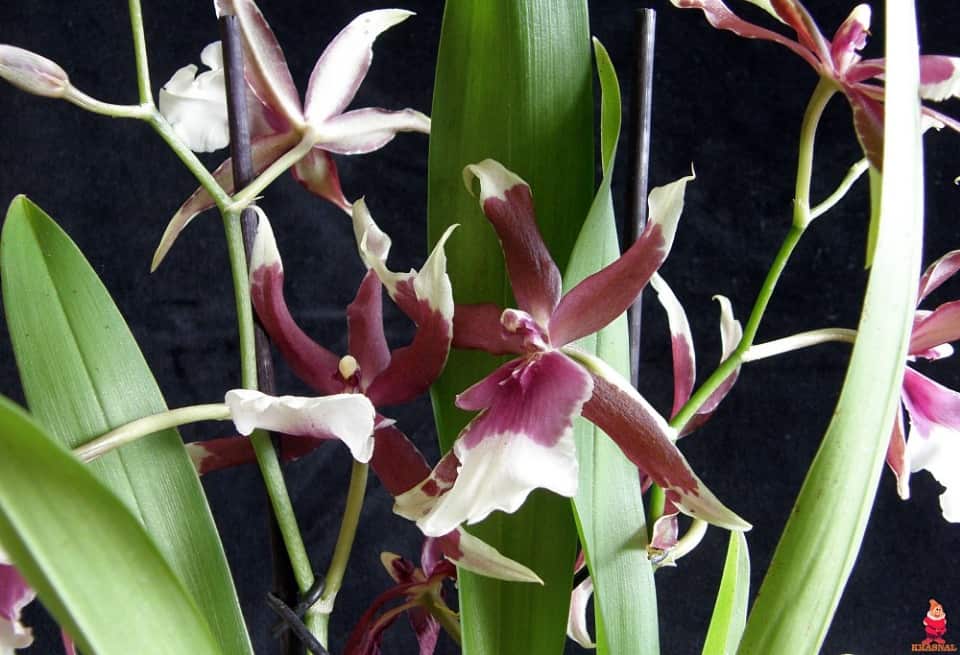

Anne Claire - on a snow-white background of petals, several velvety-cherry stains. Sepalia are elongated triangular in shape, the lip is rounded with a sunny yellow spot at the very throat.
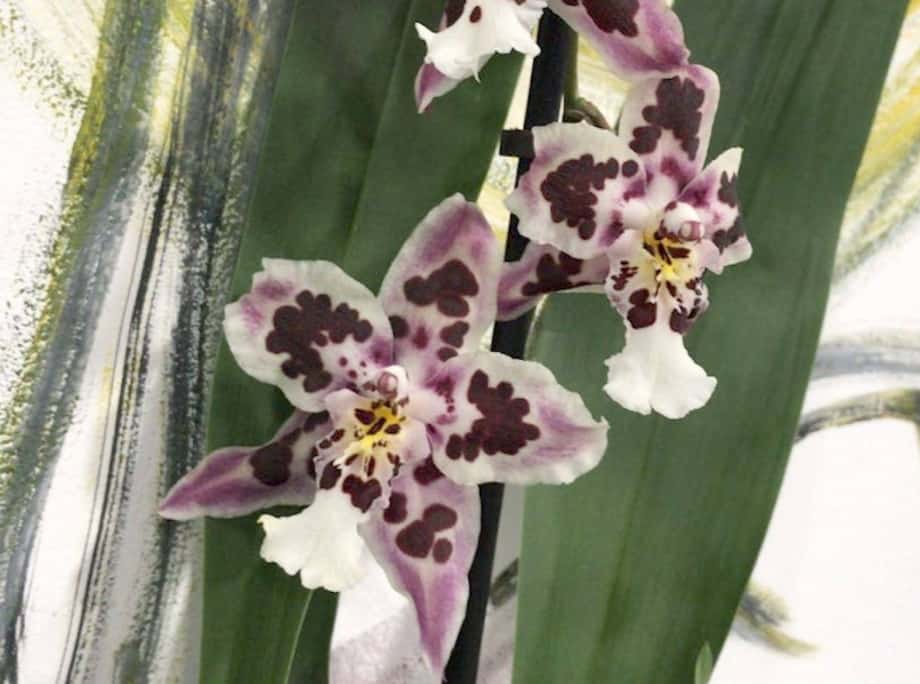

Favorit - flowers are painted in a burgundy-white spotted pattern. The lip is snow-white in small dark cherry grains, from the center of the throat a sun-yellow tongue of a blazing light slides down it.
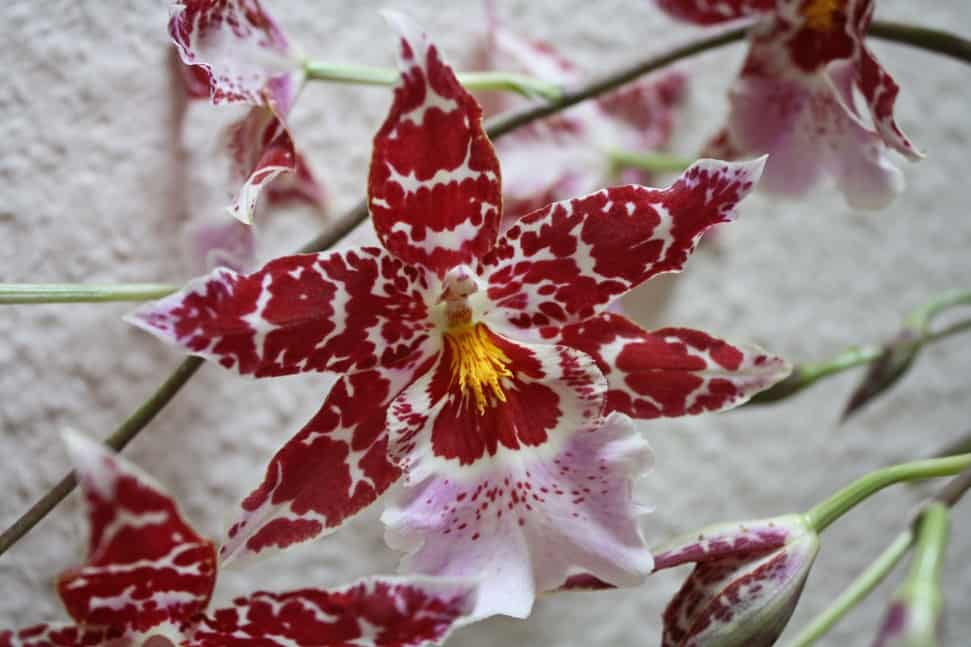

Table: Seasonal Household Content
| Season | Temperature | Lighting | Humidity |
| Spring Summer | The ideal temperature is 22–26 ° C. Difference between day and night indicators - no more than 6оС | The plant needs bright, but diffused light.Eastern, northeastern, western windows with shade from the midday sun will do. | 25–30% humidity, 35–40% during flowering. For spraying, use settled soft water. At temperatures above 22 ° C, spraying the air around the plant can be done twice a day. |
| Autumn winter | Temperature regime within 16-18 ° C | South, east, west windows shaded from the sun's rays. If the plant blooms at this time, then it needs additional lighting (phytolamps or fluorescent lamps). |
Growing a flower culture
The orchid is grown at home. Reproduction of culture in most cases is carried out by dividing the bush part. When planting, the bulbs are separated from each other. It is important not to damage the root system. If reproduction ended in damage to the bush, the remaining bulb is treated with activated carbon - this way the rhizome will be protected from infections.
Reproduction of the plant occurs in the warm season, when the young stem quickly takes root. Until the seated bulbs have taken root, they are reinforced with support. Any stick that is previously disinfected is suitable as a support. The first watering or other care procedure is carried out no earlier than a week after planting.
Disembarkation stages
Plants reproduce in different ways. The most popular way is to divide the bush, which is carried out in early spring, when the orchid starts up new bores. They are transplanted into fertilized soil and are well watered. Other types of disembarkation:
- with the help of a seedling;
- dividing the bush.
The root planting method (dividing the bush) is not only the easiest, but also the cheapest. The separated roots are carefully cleaned and processed with wood powder. After that, the planting material takes root. The roots are detached with an ordinary knife, after which the cut site is processed. The material sits in a pot with a substrate. Additionally, the new bore is sprayed with water. The shoots should be at least 3-5 cm. The pot should have drainage layers or holes so that the water does not stagnate.
For planting a culture using a seedling, a purchased flask with planting material is used. The flask is broken, the planting material is washed and soaked in a solution of potassium permanganate. After cleaning, the seedling is dried and planted in a special nutrient substrate. The planting material is immediately cared for.
Cambria Orchid (Cambria) care and reproduction at home
You need to transplant cambria every 2 or 3 years. You can understand that a plant needs a transplant by the following signs:
- roots protrude from the drainage holes or directly from the top of the flowerpot;
- the bush has increased significantly in size;
- the substrate began to rot;
- there were problems with the orchid itself.
For cambria, a special substrate for epiphytes is suitable, containing bark of fine and medium fractions. In addition to her, such a soil mixture contains moss, charcoal, fern roots and coconut flakes. This is exactly what the orchid needs. The pot itself should be slightly larger than the previous one, but without fanaticism. If the vessel is too spacious, the bark will not have time to dry out and the cambria can rot.
Cumbria reproduces well at home. The method of choice is multiplication by division. It is important that at least three bulbs remain on each part when dividing the bush. Separate pseudobulbs carefully so as not to damage the roots. The tool should be treated with antiseptics, and the sections should be rubbed with charcoal.
Planting and caring for is painstaking, careful work, so it is always necessary to approach it with the utmost seriousness.

